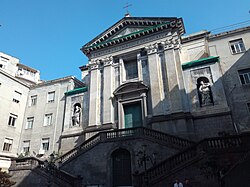Carlo Vanvitelli
- View a machine-translated version of the Italian article.
- Machine translation, like DeepL or Google Translate, is a useful starting point for translations, but translators must revise errors as necessary and confirm that the translation is accurate, rather than simply copy-pasting machine-translated text into the English Wikipedia.
- Do not translate text that appears unreliable or low-quality. If possible, verify the text with references provided in the foreign-language article.
- You must provide copyright attribution in the edit summary accompanying your translation by providing an interlanguage link to the source of your translation. A model attribution edit summary is
Content in this edit is translated from the existing Italian Wikipedia article at [[:it:Carlo Vanvitelli]]; see its history for attribution. - You may also add the template
{{Translated|it|Carlo Vanvitelli}}to the talk page. - For more guidance, see Wikipedia:Translation.

Carlo Vanvitelli (1739–1821) was an Italian architect and engineer, who worked mainly in Naples and its surrounding area.
He was the son of architect Luigi Vanvitelli, and two of his brothers were also architects. Together with Pietro, he apprenticed under his father in the construction of the Palace of Caserta. Both worked at the decoration in Piazza Dante in Naples and at Villa Giulia. During the last years of his father's life, he resided in Caserta directing the works; when Luigi died (1773), Carlo Vanvitelli became director of the construction.

His other works include Palazzo Berio, Villa Reale, and Palazzo Doria d'Angri.

Biography
Charles and Peter had the same instruction, both worked in the yard of the Palace of Caserta and participated in the construction of the Aqueduct of Vanvitelli with Francesco and Pietro Bernasconi. In 1759 they collaborated with their father at the Foro Carolino. Their last collaboration was the Collecini for the relief of the Casino di San Nicandro in Barra.
Sources
- Costanzo, Salvatore (2006). La Scuola del Vanvitelli. Dai primi collaboratori del Maestro all'opera dei suoi seguaci. Naples: Clean edizioni.








